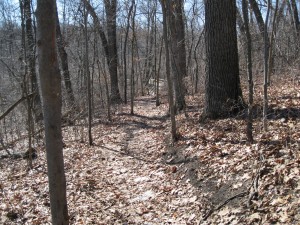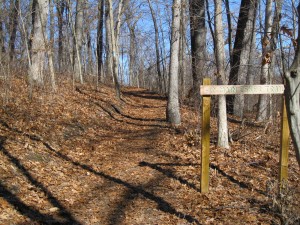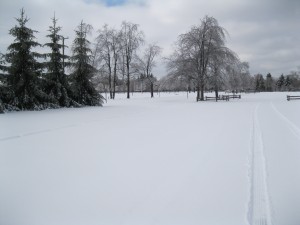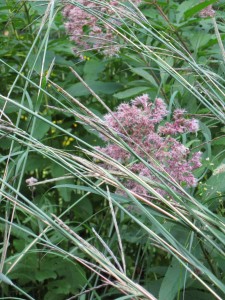Saturday, the day after the date of the original Earth Day, was the next to last stewardship work day scheduled for the spring at the Mildred Harris Audubon Sanctuary. Katy and I started within the east edge of the beech-maple forest, that is, within the forest proper ignoring the border with briars and fallen wood where garlic mustard forms frequent dense patches. We began at the road, F Avenue and walked compass lines south about 10 meters apart to the south boundary of the Audubon property.
The point was to pull up all the garlic mustard plants we found along our line and between us. Katy got a large green plastic trash bag almost 2/3 full and mine was about 1/4 full. At this stage, the plants are still basal clumps with no evidence of stalks that will bear flowers. It’s desirable to remove flowering plants from the site; there is at least anecdotal evidence that such plants if tossed on the ground may proceed to produce fruits and set seed. But I wonder if plants at the stage they are now need to be hauled out. Certainly, some soil and nutrients contained in the plant tissue are removed from the site this way, which has some negative consequences.
When we got back home, I laid eight of our pulled-up plants (four large and four small) on the ground in the oak woods where we live. To give them the best possible chance, I raked off the oak litter. I’ll follow them for at least a couple of weeks and see what happens.

Garlic mustard plants pulled at Harris Sanctuary staked out in Oshtemo Township. Photo 23 April by Richard Brewer
Perhaps this super invasive will manage to point its roots down and send a shoot up and be back in business. Or maybe it will turn out to be only mortal and all eight will shrivel, die, and blow away. We’ll see.
As to other phenological events, Toothwort is blooming, as is spring beauty. So is Dutchman’s breeches, though the flowers on most of the plants and still cream-colored and knobby rather than white and puffy the way Dutch boys pants are supposed to have been. I saw leaves of a species of waterleaf (Hydrophyllum) but, of course, no buds or flowers. Waterleaf is not one of the spring ephemerals. The shrub spicebush was also in bloom.
I saw several patches of soil where the dead maple leaves had been removed–scratched away by Wild Turkeys I concluded, based on an occasional bird dropping of the appropriate large size near one of the patches. Turkeys seem considerably more common in and around the sanctuary than a few years ago.
Katy and I completed one pass from north to south along the east side of the forest and then walked back through the same strip, finding a couple more garlic mustard plants. Then we called it a morning about 9:30.
No other Audubonites had shown up for the scheduled and publicized work day. When we drove up at just before 9AM, a white van was parked alongside the road ahead of us on F Avenue. But when I checked to see if they might be volunteers, it was only a family attracted by displaying turkeys not far off the road in the woods north across from the Audubon Preserve.
Wednesday, April 27, was supposed to be the last Harris work day of the spring but we decided to cancel it. As we announced at the Audubon Society of Kalamazoo meeting Monday night 25 April, we’ll reschedule for Saturday, 7 May 9 AM and see who comes then. One of the things we’ll do is continue walking lines in the forest, where we have managed to keep the number of garlic mustard (and any other invasive plant) to a manageable level).
Meanwhile spring advances. Yesterday in Pavilion Township the larger clumps of garlic mustard had small flower buds. Mayapple and wild ginger were up and have flower buds (the individuals that will flower have buds when they emerge from the ground). The earliest Trillium grandiflorum are up.











